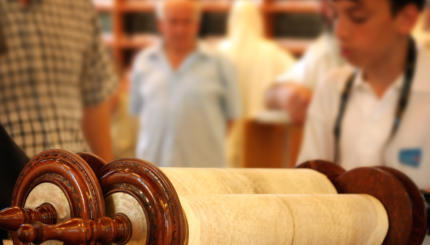The weekly Torah portion, parshat hashavuah (also spelled parashat hashavuah) serves as the focal point for much Jewish learning, from individual study to informal discussion groups to rabbis’ sermons. The Torah, also known as the Five Books of Moses or the Pentateuch, is divided into 54 separate portions, each one named for the first word or words of the passage — and each linked to a specific week. The weekly portion is read aloud, or chanted, from the Torah scroll as part of the Torah service in synagogue on Shabbat (Saturday) morning.
The Torah is part of the Tanach, or Hebrew Bible, known in Christianity as the Old Testament. Tanach is an acronym for Torah, Nevi’im (Prophets) and Ketuvim (Writings).
The weekly Torah portion is always featured on My Jewish Learning’s homepage and on our Weekly Torah Portion page, which also lists the full index of portions. In addition, most printed and digital Jewish calendars include the week’s Torah portion. To create your own customized Jewish calendar, click here.
Learn about the history of the Torah-reading cycle and the different variations on the cycle here.
On each of My Jewish Learning’s 54 Torah portions pages, you’ll find the biblical citation of the portion, so you can look it up in the Bible or on Sefaria, which has both Hebrew and English translations of the text. For each portion, My Jewish Learning has featured commentary, along with an extensive collection of other articles about the portion. At the top of each commentary you’ll find the biblical citation; click on it to go directly to the text on Sefaria. To find more Torah portion commentaries, read our Guide to Weekly Torah Commentaries Online.
To find the Hebrew equivalent for a specific date on the secular calendar — such as your birth date or the date of an upcoming bar/bat mitzvah — use the tool below. Enter the date here to find the Torah portion associated with it.
Below are the names of the Torah’s five books (each portion is a section within a book) and a brief summary of each (click on them for longer summaries):
Genesis (“Origins”)/Bereishit (“In the Beginning”) tells the story of creation, Noah and the flood, and the selection of Abraham and Sarah and their family as the bearers of God’s covenant. Stories of sibling conflict and the long narratives of Jacob and his favorite son Joseph conclude with the family dwelling in Egypt.
Exodus (“The Road Out”)/Shemot (“Names”) tells of how the family of Jacob grew and then was enslaved in Egypt. The baby Moses, born of Israelites but adopted by Pharaoh, becomes God’s prophet who, after bringing 10 plagues down upon Egypt, leads the Israelites through the Red Sea to freedom and to the revelation at Mount Sinai. The story of the Israelites worshipping the golden calf, which follows soon after the revelation at Mount Sinai, is almost obscured by lengthy materials on the building of a sanctuary (tabernacle) in the wilderness.
Leviticus (“Laws of the Levites”)/Vayikra (“And God Called”) deals mostly with laws of Israelite sacrificial worship. Related rules include the basis for Jewish dietary laws (kashrut) and issues of purity and impurity. The holiness code, which describes a sanctified communal life, is a highlight of the book.
Numbers (“The Census”)/Bamidbar (“In the Wilderness”) begins with a census of the Israelites and the tribe of Levi. A group of Israelites spy out the land of Canaan; their discouraging report sends them back into the desert for an additional 38 years, during which the Israelites continue to behave badly, rebelling against the authority of Moses and his brother Aaron, and having illicit relations with Moabite women.
Deuteronomy (“Second Law”)/Devarim (“Words”) is Moses’ final message to the people of Israel before they cross over the Jordan River into Israel. Moses reminds the people of how God has redeemed the people from Egypt and of the details of the covenant between Israel and God. In stark language, Moses describes the rewards for observance of the laws of the covenant and the punishment for disobedience. Finally, Moses passes along his authority to Joshua who will lead the people into the land.
parshat hashavuah
Pronounced: par-SHAHT ha-sha-VOO-ah, Origin: Hebrew, the weekly portion of the Torah. (Each week, the Jewish community reads a specific portion of the Torah.)
parsha
Pronounced: PAR-sha or par-SHAH, Origin: Hebrew, portion, usually referring to the weekly Torah portion.



